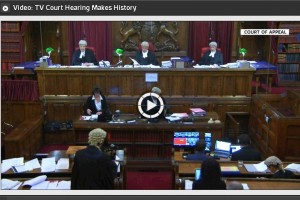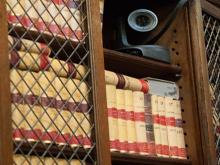Cameras in court – the Lex Factor
The promise of open justice is not fulfilled where viewers have no idea and no explanation of what is going on. Yesterday, following a change in the law, proceedings in the Court of Appeal were broadcast live on television for the first time in this country. This new development was designed to make English justice
The promise of open justice is not fulfilled where viewers have no idea and no explanation of what is going on.

Yesterday, following a change in the law, proceedings in the Court of Appeal were broadcast live on television for the first time in this country. This new development was designed to make English justice more open and accessible. But will it have that effect?
The first hearing of the Court of Appeal to be broadcast live on television, via Sky TV (though the project is also funded by broadcasters ITN and the BBC, as well as the Press Association), was an application in the court’s Criminal Division for leave to appeal against sentence. This is what happened.
Silence. Court rise.
Alexander Cameron QC : “My Lords. I will take the facts as read … as I know my Lords will have read the grounds of appeal.”
And there you have it in a nutshell. Why this exercise is little more than a vanity project, an empty gesture at openness. A picture tells a thousand words, but not if those words remain unsaid. What a sham(e)!
So you can look and you can listen. But you can’t possibly know what’s going on, unless and until someone else explains it, or you are allowed – as you should be allowed – to look at the public – or what should be public – documents in the case. What in the United States and some other common law jurisdictions is called the “docket”.
In this debut case, for obvious reasons, Sky news took the trouble to interpret and explain what was going on. The case concerned forgery, on a large scale, of pound coins. In an undercover operation the police had recovered a large number of blank discs intended to be used for that forgery, together with 80,000 fake coins. The defendant, Kevin Fisher, was one of three men convicted for their part in the crime. He was sentenced to seven years imprisonment, against which he sought to appeal. But in the words of Pitchford LJ, giving judgment, the sentence wasn’t either “arguably wrong in principle” or “manifestly excessive”, and the application was refused.
How many of these details would you have known if the court reporter had not been there to explain it to you? You’d have to pick it up, piecemeal, from occasional crumbs falling from the lips of my learned friends and my Lords. Eventually they would have been summarised, so far as relevant, in the judgment. But it’s not exactly user-friendly.
Access to papers
This vividly demonstrates a frustration which is shared not just by any member of the public who happens to stray into a court to exercise their right to scrutinise the administration of justice, but also by those of us who go in day in, day out, to report on what’s going on, to inform the public and the legal profession. As law reporters, recording new law for the textbooks and precedents for citation in subsequent legal proceedings, we are in the slightly privileged position of being able, after judgment is given, and while we are compiling our fair and accurate report of what has been going on in court, to borrow in some cases a set of the court’s papers, what are known as the “bundles” – though they are usually in the form of several (sometimes a large number of) lever arch files full of photocopied documents and previous law reports and other “authorities”.
Ordinary members of the public do not have such access. Yet there is no reason why some of the papers in a case – the appellant’s notice and the so-called “skeleton arguments” (brief written submissions) in the Court of Appeal, the claim form in the court of first instance – should not be publicly accessible, either in the court building or, better still, online, as they are in the United States. That way, if you wanted to exercise your right to scrutinise the administration of justice, you’d have some idea of what was going on.
It would also help litigants in person – a class whose numbers are likely to swell enormously following the reduction or outright removal of legal aid in many classes of civil law claim following the coming into force on 1 April this year of the Legal Aid, Sentencing and Punishment of Offenders Act 2012 (LASPO). They would be able to find out more about the practice and procedure of the court before bringing or defending their own claims, and be better prepared for what lay ahead.
A change in the law
The broadcast was made possible thanks to a selective disapplication of the effect of section 41 of the Criminal Justice Act 1925 by virtue of section 32 of the Crime and Courts Act 2013. Section 41 of the 1925 Act did not apply to the UK Supreme Court, whose proceedings have been broadcast for some time and whose decisions (but not the entire judgments) are summarised on a special YouTube channel.
The proposal to extend similar coverage to the Court of Appeal (and eventually to sentencing remarks in the Crown Court) is supported by the Lord Chief Justice, Lord Thomas of Cwmgiedd, and the Master of the Rolls, Lord Dyson. In a speech entitled “Advances in Open Justice in England and Wales“, Lord Dyson MR, on 18 October, began by quoting the 19th century philosopher Jeremy Bentham:
“Publicity is the very soul of justice. It is the keenest spur to exertion, and the surest of all guards against improbity. It keeps the judge himself, while trying, under trial.”
He said that the introduction of TV cameras was one of a number of “important means of bringing court proceedings to a far wider public audience than in the past”. Others included the use, and permission to use in court, electronic communications and social media such as Twitter and the establishment of the Judicial Communications Office (JCO) (or as it is now known the Judicial Office Communications Team, which manages the Judiciary website), and the Judicial Media Panel.
Three days later Lord Thomas CJ, in a speech entitled “Justice in One Fixed Place or Several?“, which was mostly concerned with the decentralisation of court hearings from London to provincial court centres, and the better use of legal resources at lower fees outside London, added by way of a postscript that “I and my fellow judges welcome the recording of the proceedings [by TV cameras in the Court of Appeal]. We believe it will help assist understanding of the way in which the courts work and enable the public to see the way justice is delivered in an even more open and transparent manner than at present.”
His remarks were themselves captured in a recording made by Joshua Rozenberg and the BBC for his radio programme, Law in Action, which on 22 October broadcast a discussion on the subject in which Baroness Helena Kennedy voiced her concerns that televising courts, far from enhancing public understanding, would simply feed the media’s insatiable appetite for scandal and salacity.
The televising of the Supreme Court demonstrates that sober coverage can be made available, and anyone interested (the viewing figures are modest) can watch it, even if the news media choose to report from it only selectively. The same is true of attending court in person. As Lord Dyson MR points out, “the days when a journalist sat in court all day have gone.” Indeed, the days when most journalists knew what you could and couldn’t report have also largely gone. But if they are not even in court because they can cover the case on TV, how will they make sure they get the whole picture?
The people who DO stay in court, often throughout the hearing, are the law reporters. And when it comes to the law, it is still our primary duty to explain and record new points of principle, fairly, accurately and as timeously as these other requirements permit.
 These two forms of scrutiny, the traditional law reports and the new TV cameras, are neatly captured side by side in this image from a report in Solicitors Journal:
These two forms of scrutiny, the traditional law reports and the new TV cameras, are neatly captured side by side in this image from a report in Solicitors Journal:
For more on what The ICLR does by way of shining a light on the law, check out ICLR Online and our various print products.
For more on open justice, and the need for public access to papers or dockets, read
- David Allen-Green on his FT blog, Blind Justice and Open Justice
- Dan Bunting on his A Life in the Bus Lane blog, .Court TV – the downside.